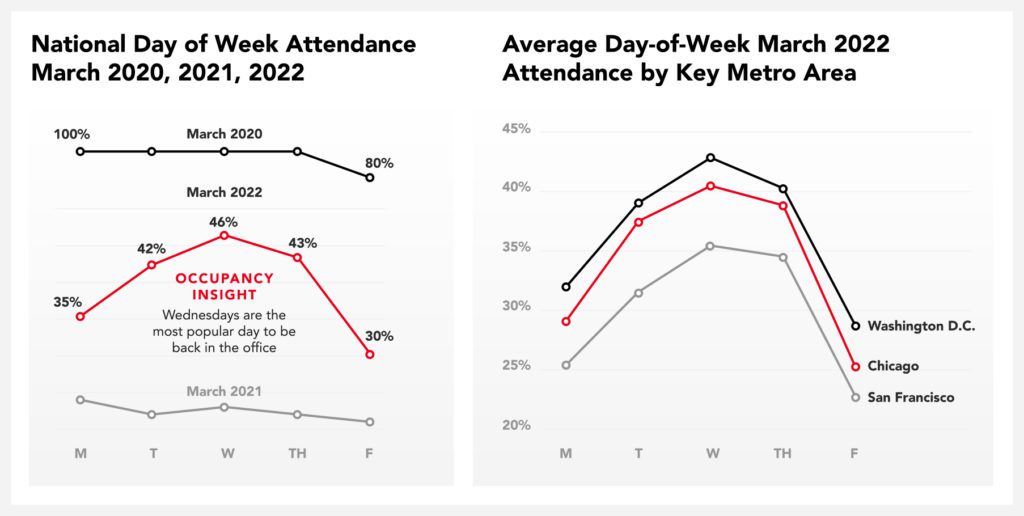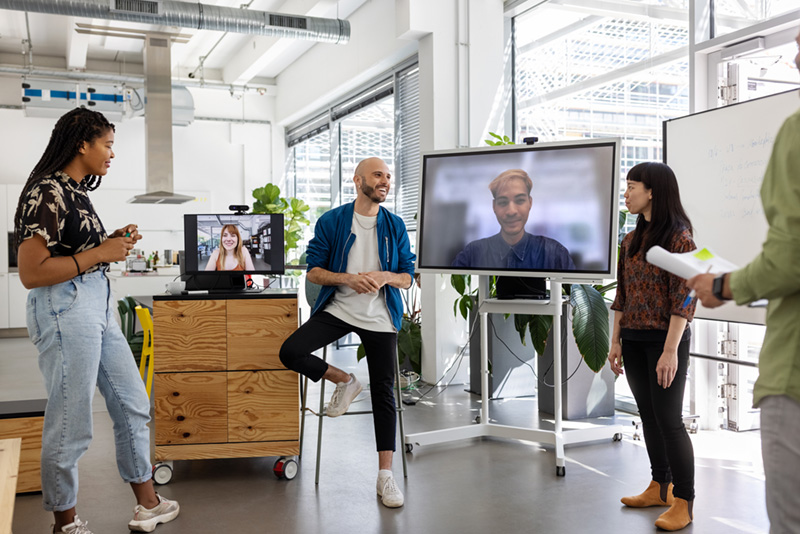“For years, Mondays haunted the weekend, a looming day when the fun would be over,” begins a recent Wall Street Journal article, “But as employers start asking work-from-home people to come in part time, a different day is taking center stage: It’s Wednesday!”
Indeed, in today’s new hybrid work routine, the peak day for employees to work from the office is the old, “hump day”. How do we know that, you ask?
Well, electronic access data confirms Wednesday as the weekly high point. Kastle, a leader in commercial access technology, publishes average weekly workplace attendance since early in the pandemic, which aggregates office entry activity across 41,000 workplaces Kastle secures nationally.
Kastle’s nation-wide average shows that Wednesday attendance peaks at 46% occupancy, compared to only 35% on Monday and a paltry 30% on Friday.
This data pattern holds true across major metros Kastle serves.
 *The 2020 attendance level is the ongoing historical benchmark for Kastle tracking, so it represents 100% of the 2020 average (Fridays were 20% below the daily average, even in 2020.)
*The 2020 attendance level is the ongoing historical benchmark for Kastle tracking, so it represents 100% of the 2020 average (Fridays were 20% below the daily average, even in 2020.)
*Includes days in February leading up to mid-March when offices shut down.
As business leaders try to understand this “new hybrid normal”, they are calling upon HR administrators to figure out these new workplace patterns to help optimize space use and productivity. Unfortunately, most managers don’t have this useful occupancy data for their own workplace, so it’s challenging.
Brian Kropp, chief of HR research for advisory firm Gartner, cites in the WSJ article that some workplace managers, “are beginning to express frustration about Wednesdays because there isn’t enough room, in the case of businesses that shed space during the pandemic in anticipation of a hybrid work strategy.
Workers are saying, “Gosh, you tell me to come in and it’s crowded. Then you say because it’s crowded, we’re not supposed to be in a conference room together. So, why am I coming in again?” Employers that have unloaded a lot of space might risk running out of room on Wednesdays.
And what about Fridays when 70% of workers stay home, yet there are still people in the office – do you know who they are? Are they supposed to be there? It can be nerve-racking to worry about keeping an office secure, from computers systems to employees, when you are not there yourself, and you’re not sure who is.
As weeks go by, these daily patterns will likely change as workplaces adjust – Tuesdays or Thursdays could become the peak. But that’s the point. In a hybrid work environment attendance WILL change, and administrators need to gauge how it is evolving so that they can manage people and space effectively.
So, what does your workplace attendance look like?
Is your leadership asking for reporting to help with office planning, or down-sizing (or up-sizing)? Do you have sign-in sheets? Do you take roll as people enter? Do you feel confident that no keys or combination codes are being shared or stolen?
A simple cloud-based access package that records daily entry activity can make this data available for easy reporting from anywhere, while maintaining control over who can, or cannot, enter your workplace. An electronic door reader, a controller and access credentials are all you need. Safer, more accurate, and far more convenient than using access codes, or (gasp) metal keys.
You can easily implement a mobile access solution, where credentials reside on employee’s smart phones, so there are no keys or cards to lose, forget, or have stolen. Further, the easy programming of the app makes it flexible to integrate with future technologies, so your system never gets outdated.
Here’s what you need to secure your office in the new hybrid schedule.
First, select a cloud-based access provider so that your data is easily accessible from anywhere – and provides remote 24/7 monitoring so you know your space is secured by real professionals even when you are not there.
Second, get basic hardware that includes an electronic access reader at your entry with electronic door locks to maintain secure entry continuously (and only opens if the appropriate credential is scanned).
Third, get the controller which is where the software transmits intelligence for the locking to function and passes data to the cloud. Security upgrades are pushed from the cloud directly to the controller on a regularly, to maintain performance.
It’s a simple package to implement quickly (but don’t do it yourself). Kastle has a base tenant package for you to reference right here.
Good luck and welcome to hybrid work!

